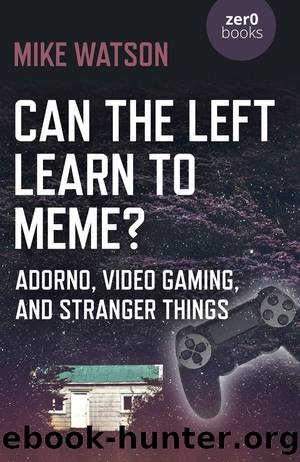Can the Left Learn to Meme? : Adorno, Video Gaming, and Stranger Things (9781785357244) by Watson Mike

Author:Watson, Mike
Language: eng
Format: epub
Publisher: Natl Book Network
Published: 2019-10-04T00:00:00+00:00
Seemingly modelled on the actual public reaction to Manetâs Le déjeuner sur lâherbe (Lunch on the Grass) featuring two reclining clothed men, a reclining nude woman and a bathing semi-nude woman, Zolaâs account points to the real and lasting achievement of Post-Impressionist art, with its focus on forms, colours and everyday people. Perhaps there is something extraordinary in Manetâs Le déjeuner sur lâherbe, which bears some resemblance to the contemporary niche pornographic market âCMNFâ (clothed male, nude female). Though aside from its display of flagrant nudity for its own sake, the real innovation lay in the fact the nude female could have been anyone (as opposed to being a figure from Greek myth, for example) â as could the clothed male.
Returning to Woolfâs assertion that a change in human character coincided with the opening of Manet and the Post Impressionists it could be asserted that the bright colours, expansive strokes, rhythmic lines and everyday scenes associated with the Post-Impressionist style heralded a kind of democratisation of the arts. In the quasi-folk musicality of the works of the Post Impressionists people began to recognise themselves, thereby bringing about extremes of emotion and above all laughter, an expression often associated with a kind of truce or a relaxing of oneâs guard in the face of a person or object. The publicâs laughter in the face of Post Impressionism was one step in a long process that has opened up art to ever wider audiences by releasing the grip of socially exclusive academic conventions on art and its appreciation. Whatever people thought of the 1863 Paris Salon, they didnât need an education in Classics or Theology to understand what they were looking at. They didnât need particularly to understand it at all.
Post Impressionism marked one large step in a process of opening the public to an unadulterated relationship with the artwork, to an immediacy of experience that challenged a prior bourgeois preoccupation with rules and conventions. That process continued with the advent of conceptualism and the notion that anything could be art, which is generally traced back to 1914 when Marcel Duchamp declared an upturned bottle rack to be an artwork, and can later be seen in Andy Warholâs presentation of Campbellâs Soup tins and Brillo Pad boxes as worthy objects of cultural appreciation. Itâs a process that has many different strands and histories that wonât be analysed in depth here except to say that itâs one that was sped up and amplified to a massive (so big as to be unquantifiable) degree with the advent of the internet, which has become a global salon providing the freedom of creative expression and reception that we have idealistically longed for since at least early modernism.
While there are plentiful examples of internet censorship and while surveillance is rife, it remains that more images (including texts) and sounds are being made and consumed (often for free aside from the cost of an internet connection) than ever before. This is as close as weâve ever been to
Download
This site does not store any files on its server. We only index and link to content provided by other sites. Please contact the content providers to delete copyright contents if any and email us, we'll remove relevant links or contents immediately.
The Hynek UFO Report by J. Allen Hynek(355)
The Cultural Life of Modenr America by unknow(306)
Nicki Minaj: HIP POP MOMENTS 4 LIFE by ISOUL HARRIS(214)
Can the Left Learn to Meme? : Adorno, Video Gaming, and Stranger Things (9781785357244) by Watson Mike(129)
